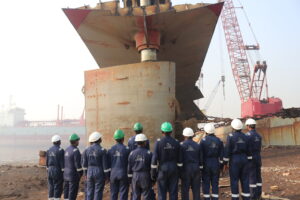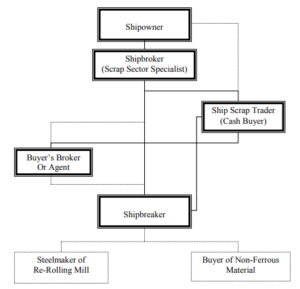- Leading ship recycling company and has been established in 1983
Ship Recycling 101: Understanding the Basics with RLK
Ship recycling is a long-standing practice for dealing with ships at the end of their operational life. The entire process comprises different stages of document review, material management, the dismantling of the ship, decontamination, and several others. In this “‘Ship Recycling 101: Understanding the Basics with RLK,” we will delve deeper into the basics of ship recycling and uncover the different stages of the shipbreaking process. This guide will leave you with a basic understanding of the fundamental concepts of ship recycling, along with the terminology and processes involved.

An Overview of Different Stages of the Ship Recycling Process
The ship recycling process comprises various stages to simplify the entire process and follow international guidelines. Both the ship and shipyards are required to comply with shipbreaking regulations to meet specific requirements. Before the actual dismantling begins, the ship is thoroughly assessed and cleaned through the decontamination process.
The Ship Recycling Plan (SRP) provides a blueprint for the entire process and for recycling a ship in a safe and environmentally sound manner. After the ship inspections and clearance, the ship is dismantled using various gas-cutting technologies. The recovered material is segregated and sent to the re-rolling mills. The ship recycling facilities (SRF) are cleaned, and the entire process is documented and reported with a baseline report. Refer to the table below for an overview of the entire ship recycling process.
|
Stage |
Description |
| Preparation Stage | a. Ensuring adherence to international and local regulations for ship recycling is a crucial prerequisite before ship recycling. |
| b. Cataloging and documenting the ship’s components, materials, and hazardous substances by creating an Inventory of Hazardous Materials (IHM.) | |
| Ship Dismantling Stage | a. Grounding the ship on a beach or anchoring it in preparation for dismantling is followed by SRP (Ship Recycling Plan). |
| B. After the ship inspection and clearing the cutting and dismantling of the ship’s structure is done using different cutting technologies, starting with non-essential sections. | |
| Recycling and Recovery of Material Recovered | a. The recovery begins with the safe extraction and disposal of hazardous materials such as asbestos and chemicals that are disposed of using standard methods and procedures. |
| b. Salvageable materials and components are recovered. The recovery of valuable materials comprises steel, copper, and machinery for reuse or sale. | |
| Environmental Protection | a. To address the impact on the marine ecosystem, efforts are taken by the shipyard owners to mitigate the potential pollution and environmental damage. |
| B. The health and safety of workers safety is ensured and community concerns related to recycling activities are also addressed. | |
| Adherence to Global Regulations and Initiatives | a. Basel Convention – International treaty addressing the transboundary movement of hazardous wastes. |
| b. Hong Kong Convention – International agreement for the safe and environmentally sound recycling of ships. | |
| c. Industry Guidelines and Best Practices – Standards set by organizations and associations to promote responsible recycling. |
A Paradigm Shift with Green Ship Recycling

The perils of shipbreaking to the environment and shipyard workers have always been a matter of international concern. Green ship recycling brought a paradigm shift in the maritime industry as it involves towing a ship to a dock for dismantling, instead of breaking it down on the beach. This way the toxins released during shipbreaking were prevented from flowing into the ocean and impacting the marine animals.
Green ship recycling allowed the shipyard owners to easily identify, store and safely dispose of those parts of the vessels that are hazardous to both human and marine lives. To fully comprehend the basics of ship recycling knowing about green ship recycling is also important.
Future Trends and Innovation in Shipbreaking Industry
The future of the shipbreaking industry paves its way through green ship recycling and a circular economic approach. The circular economic approach focuses on reducing waste and using resources wisely by cycling, extending product life, intensifying usage, and reducing material and energy waste. The latest technological advancements such as automation can completely change the way shipbreaking is conducted all across the globe.
These new trends and innovations can further reduce the release of pollutants and contaminants and protect the ecosystem while promoting sustainable resources. Some of the key benefits of these new trends including automation, green ship recycling, and circular economy to the shipbreaking industry are briefed below:
- Increased dependence on the reuse and recycling of resources
- Minimize the environmental impact of Shipbreaking
- Less risk of accidents and pollution
- Increased safety and welfare of shipyard workers.
Conclusion
Ship recycling is a comprehensive process including various stages. The knowledge of these fundamental concepts will help you gain a better understanding of the shipbreaking process and its several stages. Besides, the basics we have also elaborated on the various important concepts related to ship recycling. With ‘Ship Recycling 101: Understanding the Basics with RLK,’ you will get a comprehensive breakdown of the journey of a ship from arriving at the shipyard until getting recycled.